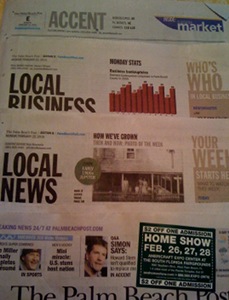As news media bleed red few journalists struggle to keep public informed
Posted by Elena del Valle on March 10, 2010

In the last few years, Americans (and others abroad) have witnessed the slow and painful breakdown of traditional print and broadcast media as the financial model that held up the media outlets became obsolete and a new one was not embraced well, quickly, efficiently, replaced with a better one or all of the above. While we wait for the dust to settle we rely on the media outlets and the journalists that remain to fill the large shoes of the many that are gutted or gone. That is a tall order. Now that they are teetering on the edge of disappearing, at least in some ways, many people have begun to realize how much they had come to rely on that news reporting in their daily lives.
Newspaper ad revenue took a nose dive a long time ago and doesn’t seem to be coming up for air any anytime soon. The industry had a 23 percent drop in ad revenue in the last two years, according to the State of the News Media 2009, a report about media in the United States. The researchers who prepared the report concluded that 20 percent or one of every five journalists working for newspapers in 2001 was no longer around by the end of 2008. They anticipated that journalist losses would be the worst in 2009. Other sources indicate this was the case.
In the newspaper segment alone more than 40,000 newspaper jobs were lost in 2009 and 21,000 were lost in 2008, according to the federal Bureau of Labor Statistics quoted in a December 2009 article by Joe Strupp of Editorandpublisher.com. That loss was more than any single year in the past 10 years. The experience and contacts of dozens upon dozens of senior journalists may be disappearing before our very eyes. As of the end of 2009 many senior newspaper editors were no longer at their jobs, and in most cases no longer in the newspaper industry. Last year lone some of the losses included senior men and women from well known national and local publications such as USA Today, Newsday, The Star-Ledger, The Oregonian, The San Diego Union-Tribune, Chicago Sun-Times and The Washington Times.
As media became fragmented and media executives searched for ad revenue to survive many lost touch with their audience. Local television stations shed news staff, saw falling, or for the lucky ones, flat ratings; and lost more revenue, 7 percent in an election year, according to the 2009 media report. Network news ad revenue fell and ratings dropped as well. Ethnic media too, which had shown signs of growth in the past, is now floundering. In 2008, the only shining light was cable news and many of those ratings increases dropped after the elections.
Meanwhile, in spite of the traditional media’s past disdain for online venues the audience has embraced new media and online media sources with a vengeance. In 2008, traffic to the top 50 news sites increased 27 percent and the number of people seeking news online went up 19 percent in two years. That could be the solution, some thought, except that the ad revenue did not follow the audience. Although two years ago ad revenue online grew about 30 percent per year two years in a row the ad revenue on online news sites stopped growing and continued declining in print.
Although nobody seems to know for sure some estimates place the revenue decline in the news industry at double previous numbers in 2008, the most recent year for which data seems available. There are those who believe the loss in revenue was even worse in network television. Last year was expected to be by far the worst all around.
The State of the News Media 2009 was the sixth edition of the Pew Project for Excellence in Journalism annual report on the state of the news media in the United States. Among the more than three dozen readers and several researchers the 2008 analysis covered 69,942 stories in an effort to find out what news media covered that year. The total was divided into 7,350 newspaper stories, 6,539 online stories, 19,796 network television stories, 21,892 cable news stories, and 14,365 radio stories.









